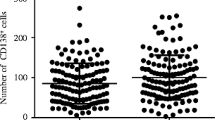Abstract
Glucocorticoid receptor (GR) was first found in the cytosol of gastric cancer tissue more than 15 years ago. At present, most gastric cancers are diagnosed at the advanced stage. To elucidate the role of GR in gastric cancer, the GR levels of the cancer tissue of 75 consecutive patients with grossly serosa-involved gastric carcinoma were determined by the dextran-coated charcoal method. The clinicopathologic characteristics and long-term survival duration were compared in patients with GR-positive and GR-negative cancer cells. We found that GR could be detected in the cytosol of cancer cells in 31 (41.3%) of the gastric cancer patients with a median concentration of 18.5 (range, 1.03–73.9) fmol/mg protein. No significant differences could be found in any clinicopathologic characteristic between the patients with GR-positive and GR-negative cancers. After multivariate analysis, gross Borrmann’s type, metastatic lymph node number, and GR positivity were the independent prognostic factors after gastrectomy for serosa-involved gastric carcinoma. GR-positive gastric cancer had a worse survival rate than GR-negative gastric cancer. Multimodality adjuvant therapies should be considered in patients with GR-positive serosa-involved gastric carcinoma.
Similar content being viewed by others
References
Taiwan Department of Health. General Health Statistics: 1999, Taiwan Health and Vital Statistics. Taipei, Taiwan: Department of Health, Executive Yuan, 1999, p. 75.
Wu C-C, Chen J-T, Chang M-C, et al. Optimal surgical strategy for potentially curable serosa-involved gastric carcinoma with intraperitoneal free cancer cells. J Am Coll Surg 1997;184:611–617.
Katai H, Yoshimura K, Maruyama K, Sasako M, Sano T. Evaluation of the new international union against cancer TNM staging for gastric carcinoma. Cancer 2000;88:1796–1800.
Maruyama K, Okabayashi K, Kinoshita T. Progress in gastric cancer surgery in Japan and its limits of radicality. World J Surg 1987;11:418–425.
Japanese Gastric Cancer Association. Japanese classifications of gastric carcinoma - 2nd English edition. Gastric Cancer 1998;1:10–24.
Lui WY, P’eng FK, Chang YF, et al. Analysis of glucocorticoid receptors in human hepatocellular carcinoma and hep G2 cells. Hepatology 1993;18:1167–1174.
Ramos RA, Meilandt WJ, Wang EC, Firestone GL. Dysfunctional glucocorticoid receptor with a single point mutation ablates the CCAAT/enhancer binding protein-dependent growth expression response in a steroid resistant hepatoma cell variant. FASEB J 1999;13:109–180.
Bloomfield CD, Smith KA, Peterson BA, Munck A. Glucocorticoid receptors in adult lymphoblastic leukemia. Cancer Res 1981;41:4857–4860.
Mastrangelo R, Malandrino R, Riccardi R, Longo P, Ranelletti FO, Iacobelli S. Clinical implications of glucocorticoid receptor studies in childhood acute lymphoblastic leukemia. Blood 1980;56:1036–1040.
Carlstedt-Duke J, Wikstrom AC, Gustafsson FA. Structures, functional domains, and subcellular distribution of glucocorticoid receptor. In: Moudgil VK, ed. Steroid Receptors in Health and Disease. New York: Plenum Press, 1988, pp 71–83.
Gustafsson JA, Carlstedt-Duke J, Poellinger L, et al. Biochemistry, molecular biology, and physiology of the glucocorticoid receptor. Endocrine Rev 1987;8:185–234.
Wu CW, Wang SR, Chang TJ, et al. Content of glucocorticoid receptor and arginase in gastric cancer and normal gastric mucosa tissues. Cancer 1989;64:2552–2556.
Wu CW, Wang SR, Chien SL, et al. Regulation of arginase production by glucocorticoid in three human gastric cancer cell-lines. Life Science 1992;51:1355–1361.
Wu C-C, Fang J-H, Yang M-D, Wu T-C, Liu T-J. Gastrectomy for advanced gastric carcinoma with invasion to the serosa. Int Surg 1992;77:144–148.
Maruyama K, Sasako M, Kinoshita T, Sano T, Katai H, Okajima K. Pancreas-preserving total gastrectomy for proximal gastric cancer. World J Surg 1995;19:532–536.
Wu CC, Chen CY, Wu TC, Liu TJ, P’eng FK. Cholelithiasis and cholecystitis after gastrectomy for gastric carcinoma: A comparison of lymphadenectomy of varying extent. Hepatogastroenterology 1995;42:867–872.
World Health Organization. In: Watanabe H, Jass JR, Sobin LH, eds. International Histological Classification of Tumors. Histological Typing of Esophageal and Gastric Tumors. Berlin: Springer-Verlag, 1990.
Sobin LH, Wittekind C. TNM Classification of Malignant Tumours, 5th ed. New York: John Wiley & Sons, Inc, 1997.
Ho WL, Wu CC, Yeh DC, et al. Roles of the glucocorticoid receptor in resectable hepatocellular carcinoma. Surgery 2002;131:19–25.
Scatchard G. The attraction of proteins for small molecules and ions. Ann N Y Acad Sci 1949;51:660–672.
Lowry OH, Rosenbrough NJ, Farr AZ, Randall RJ. Protein measurement with Folin phenol reagent. J Biol Chem 1951;193:265–275.
Baxter JD, Tomkins GH. Specific cytoplasmic glucocorticoid hormone receptors in hepatoma tissue culture cells. Proc Natl Acad Sci U S A 1971;68:932–937.
Sobin LH, Wittekind C. International Union against Cancer. TNM Classification of Malignant Tumors, 6th ed. New York: A John Wiley & Sons, Inc, 2002.
Silberman H. Perioperative adjuvant treatment in the management of operable gastric cancer. J Surg Oncol 2005;90:174–187.
Kim J-P, Yu H-J, Lee J-H. Results of immunochemosurgery for gastric carcinoma. Hepatogastroenterology 2001;48:1227–1230.
Kitamura K, Beppu R, Anai H, et al. Clinicopathologic study of patients with Borrmann type IV gastric carcinoma. J Surg Oncol 1995;58:112–117.
Kanemasa H, Ozawa H, Konishi H, et al. Distribution of glucocorticoid receptor immunoactivity in gastric mucosa of normal and adrenalectomized rat. Dig Dis Sci 1999;44:2081–2087.
Author information
Authors and Affiliations
Corresponding author
Additional information
Supported by Taichung Veterans General Hospital, grant numbers TCVGH 914607C and 924603C (to C.-C.W.).
Rights and permissions
About this article
Cite this article
Yeh, DC., Cheng, SB., Yu, CC. et al. Role of glucocorticoid receptor in serosa-involved gastric carcinoma after gastrectomy. J Gastrointest Surg 10, 706–711 (2006). https://doi.org/10.1016/j.gassur.2005.10.004
Published:
Issue Date:
DOI: https://doi.org/10.1016/j.gassur.2005.10.004




